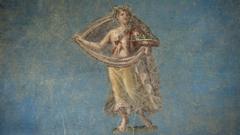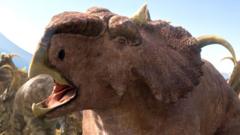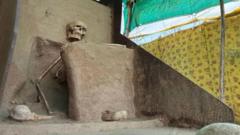In a remarkable turn of events, archaeologists excavating the ancient Roman city of Pompeii have uncovered what may be the largest private bathhouse ever found in the area, buried for two millennia under layers of volcanic ash and rock. This opulent sanctuary boasts hot, warm, and cold bathing rooms, stunning artworks, and a sizeable plunge pool, revealing the lavish lifestyle of its inhabitants.
### Rediscovering Pompeii: An Extraordinary Bathhouse Unearthed

### Rediscovering Pompeii: An Extraordinary Bathhouse Unearthed
An astonishing "once-in-a-century" archaeological discovery in Pompeii sheds new light on Roman luxury and life.
Dr. Gabriel Zuchtriegel, director of the Archaeological Park of Pompeii, states that the bathhouse encapsulates the essence of the "Pompeii effect," illustrating the city as if its people had just departed. The recently unearthed site is part of a larger excavation effort, which has provided unparalleled insights into the lives of individuals before the catastrophic eruption of Mount Vesuvius in AD 79.
The discoveries at the site include a luxurious changing room adorned in vibrant red, a mosaic floor, and intricate wall frescoes that paint a vivid picture of ancient leisure. The tranquil yet dramatic history of the location was underscored by the recent analysis of human remains—two victims of the volcanic disaster found barricaded in a small room, revealing the harrowing moments when destruction struck.
Beyond the bathhouse, the excavation has unveiled additional communal spaces such as a bakery and laundry, thought to be linked to a wealthy Roman figure, possibly Aulus Rustius Verus. This interconnectedness once again confirms Pompeii as a hub of sophisticated living and social interaction among its elite.
Despite the chaos of the eruption, the bathhouse speaks of a complex social structure characterized by stark contrasts between wealth and servitude. The boiler room, responsible for heating the baths, highlights the arduous realities faced by those enslaved during this extravagantly indulgent era.
As the excavation continues, new findings emerge daily, promising even more revelations about this ancient world. The discovery will eventually open to the public, allowing all to witness artifacts that serve as reminders of a lost civilization and the tales held within the remnants of time.
In this latest exploration, archaeologists are painstakingly unearthing pieces of Pompeii’s past. As Dr. Anna Onesti, director of the excavation, remarks, each day holds surprises, granting us a magical glimpse into the lives led before nature’s wrath forever altered this extraordinary city.
###
Rediscovering Pompeii: An Extraordinary Bathhouse Unearthed
An astonishing "once-in-a-century" archaeological discovery in Pompeii sheds new light on Roman luxury and life.
In a remarkable turn of events, archaeologists excavating the ancient Roman city of Pompeii have uncovered what may be the largest private bathhouse ever found in the area, buried for two millennia under layers of volcanic ash and rock. This opulent sanctuary boasts hot, warm, and cold bathing rooms, stunning artworks, and a sizeable plunge pool, revealing the lavish lifestyle of its inhabitants.
Dr. Gabriel Zuchtriegel, director of the Archaeological Park of Pompeii, states that the bathhouse encapsulates the essence of the "Pompeii effect," illustrating the city as if its people had just departed. The recently unearthed site is part of a larger excavation effort, which has provided unparalleled insights into the lives of individuals before the catastrophic eruption of Mount Vesuvius in AD 79.
The discoveries at the site include a luxurious changing room adorned in vibrant red, a mosaic floor, and intricate wall frescoes that paint a vivid picture of ancient leisure. The tranquil yet dramatic history of the location was underscored by the recent analysis of human remains—two victims of the volcanic disaster found barricaded in a small room, revealing the harrowing moments when destruction struck.
Beyond the bathhouse, the excavation has unveiled additional communal spaces such as a bakery and laundry, thought to be linked to a wealthy Roman figure, possibly Aulus Rustius Verus. This interconnectedness once again confirms Pompeii as a hub of sophisticated living and social interaction among its elite.
Despite the chaos of the eruption, the bathhouse speaks of a complex social structure characterized by stark contrasts between wealth and servitude. The boiler room, responsible for heating the baths, highlights the arduous realities faced by those enslaved during this extravagantly indulgent era.
As the excavation continues, new findings emerge daily, promising even more revelations about this ancient world. The discovery will eventually open to the public, allowing all to witness artifacts that serve as reminders of a lost civilization and the tales held within the remnants of time.
In this latest exploration, archaeologists are painstakingly unearthing pieces of Pompeii’s past. As Dr. Anna Onesti, director of the excavation, remarks, each day holds surprises, granting us a magical glimpse into the lives led before nature’s wrath forever altered this extraordinary city.
The discoveries at the site include a luxurious changing room adorned in vibrant red, a mosaic floor, and intricate wall frescoes that paint a vivid picture of ancient leisure. The tranquil yet dramatic history of the location was underscored by the recent analysis of human remains—two victims of the volcanic disaster found barricaded in a small room, revealing the harrowing moments when destruction struck.
Beyond the bathhouse, the excavation has unveiled additional communal spaces such as a bakery and laundry, thought to be linked to a wealthy Roman figure, possibly Aulus Rustius Verus. This interconnectedness once again confirms Pompeii as a hub of sophisticated living and social interaction among its elite.
Despite the chaos of the eruption, the bathhouse speaks of a complex social structure characterized by stark contrasts between wealth and servitude. The boiler room, responsible for heating the baths, highlights the arduous realities faced by those enslaved during this extravagantly indulgent era.
As the excavation continues, new findings emerge daily, promising even more revelations about this ancient world. The discovery will eventually open to the public, allowing all to witness artifacts that serve as reminders of a lost civilization and the tales held within the remnants of time.
In this latest exploration, archaeologists are painstakingly unearthing pieces of Pompeii’s past. As Dr. Anna Onesti, director of the excavation, remarks, each day holds surprises, granting us a magical glimpse into the lives led before nature’s wrath forever altered this extraordinary city.
###
Rediscovering Pompeii: An Extraordinary Bathhouse Unearthed
An astonishing "once-in-a-century" archaeological discovery in Pompeii sheds new light on Roman luxury and life.
In a remarkable turn of events, archaeologists excavating the ancient Roman city of Pompeii have uncovered what may be the largest private bathhouse ever found in the area, buried for two millennia under layers of volcanic ash and rock. This opulent sanctuary boasts hot, warm, and cold bathing rooms, stunning artworks, and a sizeable plunge pool, revealing the lavish lifestyle of its inhabitants.
Dr. Gabriel Zuchtriegel, director of the Archaeological Park of Pompeii, states that the bathhouse encapsulates the essence of the "Pompeii effect," illustrating the city as if its people had just departed. The recently unearthed site is part of a larger excavation effort, which has provided unparalleled insights into the lives of individuals before the catastrophic eruption of Mount Vesuvius in AD 79.
The discoveries at the site include a luxurious changing room adorned in vibrant red, a mosaic floor, and intricate wall frescoes that paint a vivid picture of ancient leisure. The tranquil yet dramatic history of the location was underscored by the recent analysis of human remains—two victims of the volcanic disaster found barricaded in a small room, revealing the harrowing moments when destruction struck.
Beyond the bathhouse, the excavation has unveiled additional communal spaces such as a bakery and laundry, thought to be linked to a wealthy Roman figure, possibly Aulus Rustius Verus. This interconnectedness once again confirms Pompeii as a hub of sophisticated living and social interaction among its elite.
Despite the chaos of the eruption, the bathhouse speaks of a complex social structure characterized by stark contrasts between wealth and servitude. The boiler room, responsible for heating the baths, highlights the arduous realities faced by those enslaved during this extravagantly indulgent era.
As the excavation continues, new findings emerge daily, promising even more revelations about this ancient world. The discovery will eventually open to the public, allowing all to witness artifacts that serve as reminders of a lost civilization and the tales held within the remnants of time.
In this latest exploration, archaeologists are painstakingly unearthing pieces of Pompeii’s past. As Dr. Anna Onesti, director of the excavation, remarks, each day holds surprises, granting us a magical glimpse into the lives led before nature’s wrath forever altered this extraordinary city.





















